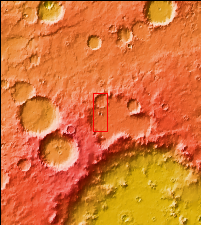
Context image Today's VIS image shows two craters in Terra Cimmeria just north of Kepler Crater. The small crater in the middle of the image is a relatively new crater. The interior rim has gullies, but the bowl shape shows that there has been very little deposition of materials. Additionally, the radial emplacement of thin ejecta is still identifiable, and can be seen in the larger crater in the top of the image. With time the crater floor will flatten due to influx of materials and the subtle radial ejecta will be hidden by dust. While the actual age of the small crater is not known, it is relatively younger than the larger crater.
Orbit Number: 66523 Latitude: -44.3019 Longitude: 139.301 Instrument: VIS Captured: 2016-12-12 09:31
Please see the THEMIS Data Citation Note for details on crediting THEMIS images.
NASA's Jet Propulsion Laboratory manages the 2001 Mars Odyssey mission for NASA's Science Mission Directorate, Washington, D.C. The Thermal Emission Imaging System (THEMIS) was developed by Arizona State University, Tempe, in collaboration with Raytheon Santa Barbara Remote Sensing. The THEMIS investigation is led by Dr. Philip Christensen at Arizona State University. Lockheed Martin Astronautics, Denver, is the prime contractor for the Odyssey project, and developed and built the orbiter. Mission operations are conducted jointly from Lockheed Martin and from JPL, a division of the California Institute of Technology in Pasadena.

